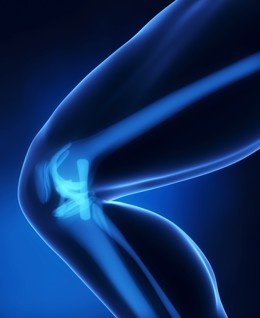Knee joint, the largest joint in the body, is dependent on muscles and ligaments (connective tissue) for strength and support. This article presents information regarding the ligaments of the knee joint.

The knee joint is the largest joint in the body. It forms a hinge between the thigh bone and the bones of the lower leg known as tibia and fibula. It is one of the most complicated joints in the human body and is made up of two articulations, one between the femur and tibia and another between the femur and patella. It is a pivotal type of hinge joint that permits easy flexion and extension as well as slight lateral and medial rotation. The knee joint is supported by muscles and ligaments that offer stability and strength to the joint.
Description
The ligaments in the knee protect the articular capsule of the knee and offer stability and strength to the knee joint. There are two main sets of ligaments that surround the knee joint: the collateral ligaments and the cruciate ligaments.
Collateral Ligaments
There are two collateral ligaments that run along either side of the knee joint:
- The medial collateral ligament is located on the inner side of the knee joint and strengthens the joint from inside. It extends from the medial femoral epicondyle to the upper inside edge of the shin bone or tibia. This connective tissue helps prevent excessive abduction of the knee.
- The lateral collateral ligament is located on the outer side of the knee joint. It extends from the lateral femoral epicondyle to the top of the fibula.
The aforementioned connective tissues, together, prevent the side to side movement of the knee joint. They also help prevent the rotation between the thigh bone and the shin. The lateral collateral ligament is flexible compared to the medial collateral ligament, and therefore is less susceptible to injury. Factors such as a twist in the knee, force that pushes the foot outward, or a direct hit to the knee may easily tear the connective tissues.
Cruciate Ligaments
These ligaments are actually short, strong bands of fibrous tissue that join the tibia to the femur. They prevent the excessive movement of the femur on the tibia.
The anterior cruciate ligament runs posterolaterally from the tibia to the base of the femur. It is attached to the lateral femoral condyle.
The posterior cruciate ligament extends from the rear of the tibia, slightly inwards, to the base of the femur. It is attached posteriorly to the medial femoral condyle. It prevents the excessive anterior movement of the femur bone on the tibia.
The posterior cruciate ligament is generally stronger than the anterior cruciate ligament, and hence injuries to the latter are quite common. Landing on a hard surface after a high jump, changing direction rapidly, and slowing down suddenly while running, etc., may tear or cause injury to the anterior cruciate ligament. This may be a serious condition compared to the injury of any other ligament of the knee since the knee joint stability gets profoundly affected. Knee exercises may help strengthen the connective tissues and muscles that surround the knee.
All the aforementioned ligaments are extremely important for the stability and strength of the knee joint. An injury to any of them may cause a serious damage to the knee.
Disclaimer:
This Buzzle article is for informative purposes only, and should not be used as a replacement for expert medical advice.


 The knee joint is the largest joint in the body. It forms a hinge between the thigh bone and the bones of the lower leg known as tibia and fibula. It is one of the most complicated joints in the human body and is made up of two articulations, one between the femur and tibia and another between the femur and patella. It is a pivotal type of hinge joint that permits easy flexion and extension as well as slight lateral and medial rotation. The knee joint is supported by muscles and ligaments that offer stability and strength to the joint.
The knee joint is the largest joint in the body. It forms a hinge between the thigh bone and the bones of the lower leg known as tibia and fibula. It is one of the most complicated joints in the human body and is made up of two articulations, one between the femur and tibia and another between the femur and patella. It is a pivotal type of hinge joint that permits easy flexion and extension as well as slight lateral and medial rotation. The knee joint is supported by muscles and ligaments that offer stability and strength to the joint.